Understand the Difference to Find Out Why Your Team isn’t Acting Like a Team
It’s natural for most people to grow frustrated with their teams at times. Perhaps one reason for your frustration is that you are not actually part of a team. Rather, you are part of a work group. True, it is easy to justify this negative feeling by stating that leaders and members of a team have different responsibilities and expectations, therefore their position as a team stands. However, frustration actually bubbles to the surface when you are part of a workgroup but expect team behaviors and processes.
What Team Work is All About
The purpose of a team is to accomplish a goal that would not be possible for just one person to achieve. A team comes together for discussion, decision-making, problem solving and planning. For instance, a team of engineers designing a computer relies on each member’s expertise to finish the end product. While the speakers, keyboard and mouse pad are designed by different people, these products alone are unusable. Therefore, their makers must collaborate often to accomplish their common goal. To sum things up, without effective teamwork, the computer would never be built.
 What Being in a Work Group Means
What Being in a Work Group Means
In a work group, two or more individuals unite for a reason or cause. As a result, they are interdependent in their accomplishments regardless of whether or not they work in the same department. In short, work groups come together to share information and perspectives. Take for instance a group of directors within a business; these professionals are interconnected but do not rely on each other for their daily jobs to be accomplished. The director of Human Resource will perform his role without the direct input from the director of Sales and Marketing. However, they are connected by the purpose of moving their organization forward.
The Difference between Work Groups and Teams
As you have probably deduced, the big difference between the two is the interconnection required to achieve a goal. On a work team, your tasks and goals can be accomplished directly by the work you perform. On the other hand, the work you do on a team and the goal you are trying to accomplish cannot be completed without the input of others on your team.
So how does that affect your leadership style?
Traditionally, managers assign work with little discussion or collaboration with their staff, forcing them to stumble around as they try to figure out what is expected from them and how to get it done. As a true leader of a work group, you will need to meet periodically with everyone to hear and share information. You will also have to work with staff members individually to set goals and determine assignments.
As for leading a team, you need to do much more than share information when you meet. Team meetings are forums for planning work, solving work problems, making decisions about work, and reviewing progress. Team leadership is participatory, in contrast to the primarily manager-driven nature of regular work groups. On a team, the manager or team leader frequently involves team members in shaping the goals and plans for getting the group’s work done.
So are you leading a team or a workgroup? Does your management style reflect the needs of your group? What tips do you have for leading these different groups? Leave a comment below.



